The soul-stirring beauty of the Scottish isles you never knew existed
The French tricolour flutters in the breeze as we sip champagne on the pool deck of our ship as she cuts through the velvety waters of the Firth of Clyde, the yawning, curling mouth of the river that links Glasgow with the Atlantic Ocean.
We’d been in the throng of Scotland’s largest city earlier this afternoon. Now it feels like we’re lost in the wilderness, surrounded by wooded banks, peninsulas and islets with craggy green mountains and storybook castles and cottages in the background.
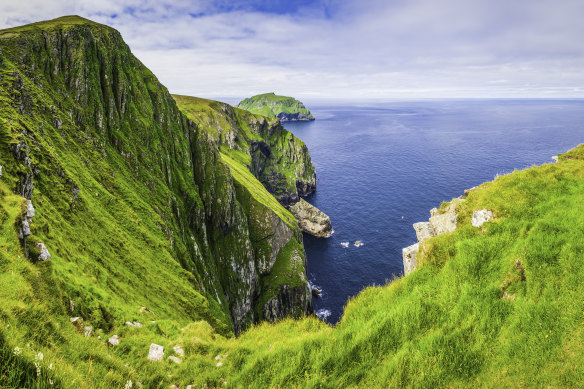
The steep cliffs and seabird colonies of Hirta.Credit: iStock
“It’s gorgeous,” says my partner, Celine, using a phrase that she’ll repeat to me more times over the coming days than in the last decade put together. Such is the moreish, soul-stirring beauty of the Scottish highlands and islands.
We’re aboard Le Boreal, a chic, yacht-like small ship by upscale French operator Ponant (hence the tricolour and the crew liberally pouring bubbly to passengers enjoying the open bar). Scotland has 790 or so islands, from ones you’ve probably heard of (Skye) to those you never knew existed (the Shiant islands, anyone?). We’ll be taking in a string of volcanic Scottish archipelagos, some more out-there and tricky to reach than others, on this new nine-night itinerary, which includes a detour to the even more remote Faroe Islands.
Adding to the cruise’s allure for me was that Scotland and France go back a long way (something I’d first gleaned by watching Braveheart in my teens). Driven by their shared antipathy to the English, the two kingdoms formed the “Auld Alliance” in the late 13th century. One consequence of that association was Scottish merchants apparently ended up getting the best wines from Bordeaux, while the English had to make do with an inferior product.
We’re in for some memorable wine and food, with Ponant having a culinary alliance of sorts with Michelin-feted chef Alain Ducasse. Complementing the a la carte and buffet dishes – Nicoise-style red mullet fillet, magret de canard and Scottish leg of lamb – are fresh salads, amuses-bouches and irresistible goodies crafted by the onboard baker and pastry chef. Then there’s the smorgasbord of obscure and deliciously pungent cheeses (Paris-born Celine is in her element – France boasts more varieties of fromage than Scotland has islands).
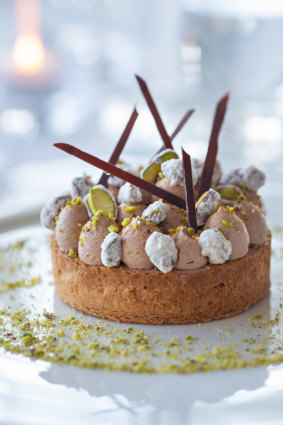
A creation of Alain Ducasse boulanger (baker) and patissier (pastry chef).
Menus are in French and English – like everything else on this cruise, including complimentary excursions with local guides and Zodiac expeditions with the team of on-board naturalists, an amiable gang of scientists, explorers and photo-journalists. Sometimes they share information first in English, then in French; sometimes in reverse. Often the non-French-speakers – making up about a third of the 193 passengers and including about a dozen Australians – are placed into English-only groups. Occasionally, there’s a bit of Franglais thrown in.
“Oh wow, it’s magnifique, extraordinaire!” says naturalist Alexandre, gawping through his binoculars at the white-tailed eagles soaring menacingly above the lofty cliffs of the Shiant Islands, a magnet for breeding seabirds in the Minch, a strait in the Outer Hebrides. As Alexandre waxes lyrical about the eagles – “they can have a wingspan of three metres!” – we see hundreds of much smaller creatures bobbing about and flying vigorously above our Zodiac. They’re Atlantic puffins, their beaks and feet a radiant orange, their wings flapping comically fast (up to 400 times a minute, says Alexandre, propelling them to speeds of around 90km/h).
We’ll see countless more of these so-called “clowns of the sea” and other birds, like guillemots, razorbills, shags, fulmars and gannets, throughout this May cruise. And we learn more about their mating and migrating patterns at the ship’s theatre, where the expedition team offers daily recaps, port previews and themed lectures. Alexandre shares anecdotes from his three decades as a falconer and how he trained birds of prey for the Harry Potter movies. Other days, his colleagues teach us about Scotland’s geological quirks, its Brexit-afflicted fishing industry and Viking legacy.
On the Shetlands, the UK’s most northerly islands, which are closer to Norway’s Bergen than Edinburgh, about 95 per cent of place names have Norse origins. From the Shetland Mainland port of Scalloway, we’re bussed past sheep-dotted heather moorland, villages like Gulberwick and Virkie then along a road bisecting the runway of tiny Sumburgh airport.
We alight at Jarlshof, described by our Shetland guide Gill as “the most important multi-period archaeological site in Europe”. Explaining how people lived here continuously for about 4000 years until the 1700s, Gill walks us through relics from various epochs, including a Bronze Age smithy workshop, a viking longhouse and a 16th-century laird’s (lord’s) mansion.
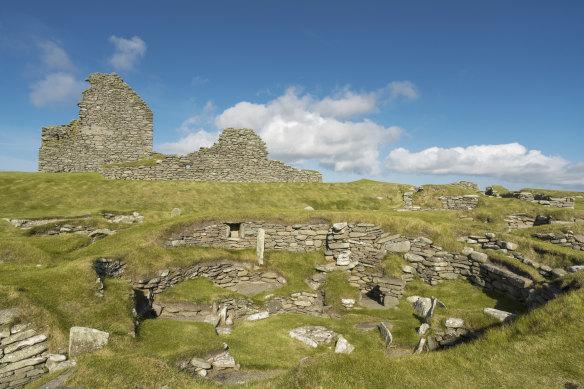
Jarlshof – the prehistoric and Norse settlement.
Jarlshof was a setting in The Pirate, a 1821 novel by Sir Walter Scott. And the great author also took inspiration from Orkney, a surprisingly green and fertile archipelago just off Scotland’s north-eastern tip. Guided by John, a retired local chemistry teacher and sea kayaking enthusiast, we discover Orkney’s UNESCO-listed neolithic monuments, including a vast ceremonial stone circle older than Stonehenge and Skara Brae, a village settled before the Giza pyramids were built. Overlooking a stunning white-sand bay caressed by turquoise waters, Skara Brae was buried in sand for centuries before a winter storm exposed the sunken remains of its stone houses in 1850.
Tempestuous weather often blasts the Scottish islands, but we mostly enjoy blue skies and mild breezes. Several afternoons we walk off lunch on leisurely loops and trails, either independently or in naturalist-led groups. On Foula, 35 kilometres off Shetland and named after the Old Norse for “bird island”, we hike with Penny, one of 35 residents here. She tells us about daily life on Foula as we stomp on boggy clifftops, staring down at seals snoozing by the harbour and meeting adorable Shetland ponies, including youths with flourishing blond manes. We’re also invited for tea and cakes at the island’s school, currently attended by four pupils.
The choppiest waters of our cruise have us swirling around St Kilda, the remotest part of the UK, 65 kilometres west of the Outer Hebrides. Humans occupied the archipelago’s biggest island, Hirta, for millennia, but by the mid-19th century the previously self-sufficient islanders felt cut off. In 1852, 36 St Kildans emigrated to Australia (barely half survived the voyage to Port Phillip). In 1930, the remaining 36 islanders were voluntarily evacuated to western Scotland.

The colours of Tobermory, Mull.
Strolling through Hirta’s abandoned village, we find cottages roof-less and crumbling, others restored into a history museum and summer lodgings for volunteers and rangers of the National Trust for Scotland, which manages the island, a UNESCO World Heritage site. Some of St Kilda’s estimated one million seabirds circle above as we hike beyond the village, passing wild sheep and lambs who teeter on the precipices of cliffs that rise over 400m above the frothing ocean.
Conditions are calmer on our penultimate day’s cruising. We’re sailing around the Inner Hebrides islands of Mull and Staffa, which enchanted everyone from Queen Victoria and Jules Verne to JMW Turner and William Wordsworth. As Staffa’s surreal caves and basalt columns capture our attention, naturalist Constance stops our Zodiac to pour us champagne. Within seconds of the toast, the glowering skies open and we receive more rain in five minutes than in the whole past week.
Believe me, though, drinking French champagne in the Scottish rain has a certain je ne sais quoi, especially when playful puffins are zipping past, verdant mountains roll in the distance and other islands, silhouetted like battleships, hover on the horizon. I look at my partner, clutching her glass, her smile visible beneath the hood of her parka. “It’s gorgeous,” she says.
The details
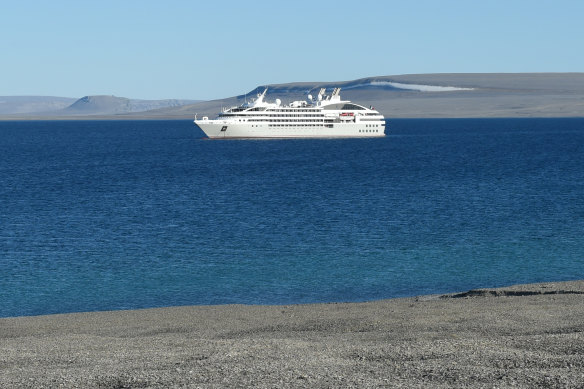
Ponant’s Le Boreal.
Cruise
Ponant’s nine-night “Scottish archipelagos and the Faroe Islands: Nordic heritage and island identities” cruise departs Glasgow on May 21, 2025 costs from $10,420 a person, with the fare including everything from WiFi to cocktails. See au.ponant.com
Fly
Emirates flies to Glasgow from Sydney and Melbourne via Dubai. See emirates.com
More
visitscotland.com
visitbritain.com
The writer travelled as a guest of Ponant
Five more cruise highlights
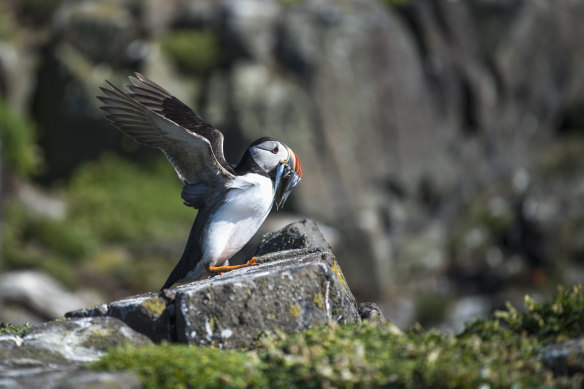
Wildlife abounds – a puffin on the Isle of May.
Gardens
Visiting Scotland in the northern spring, plants like bluebells and rhododendrons are in colourful bloom, especially at Inverewe Garden, a National Trust gem by Loch Ewe, where Ponant drops anchor.
Daylight
Whether you prefer viewing from your cabin balcony or the open-air decks and observation lounges, keep watch for birds, whales and dolphins. In May, it’s light from about 4am to after 10pm.
Souvenirs
Galleries and boutiques dot ports of call like Stromness (Orkney) and Tobermory (Mull), where you can buy everything from puffin socks to seascape paintings, plus island-produced gins and whiskies.
Lighthouses
You’ll see heaps of lighthouses, most built by the Stevenson family - engineer relatives of writer Robert Louis Stevenson. The one topping Shetland’s Sumburgh Head has a visitor centre containing vintage engines that powered the lighthouse foghorn.
Pampering
Ponant offers indulgent moments on board, including complimentary caviar tastings with live music, elegant-casual gala evenings featuring multi-course menus and hammam sessions and (paid-for) treatments at the ship’s spa.
Sign up for the Traveller Deals newsletter
Get exclusive travel deals delivered straight to your inbox. Sign up now.